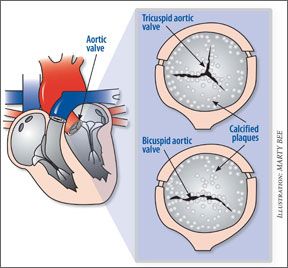While healthier lifestyle choices and treatments for a number of heart-related conditions will prolong life in many older adults, the aging population of the U.S. is still likely to see a continuing increase in aortic valve stenosis. The age-related condition results when the heart valve that opens to the bodys largest artery narrows and impedes the flow of blood from the left ventricle. The most common cause is the formation of calcified plaques on the valve leaflets that make the valve stiff and unable to close properly. About three percent of older adults have aortic stenosis, which usually requires valve replacement if it is in advanced stages. Typically, aortic valve replacement is an open-heart procedure requiring a large incision, a heart-lung machine (because the heart is stopped during surgery) and a lengthy recovery time. But as the demand continues to rise, new, less-invasive treatments are being developed that will make valve surgery available to patients who might have been considered too frail for traditional surgery. "Weve been making amazing strides in our understanding and treatment of aortic stenosis," says Cleveland Clinic cardiac surgeon Eric Roselli, MD. "And patients tend to do very well after the surgery."
To continue reading this article or issue you must be a paid subscriber.
Sign in






